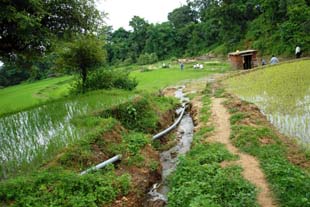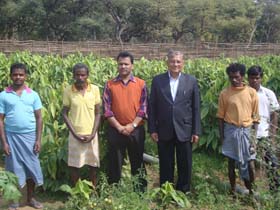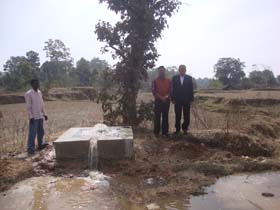Lift irrigation system ensures Lac Integrated Farming System in Rainfed Area
Mangobandh, a tribal village in Ranchi district (Jharkhand) is a rainfed area where most of the farmers practice mono-cropping of local paddy cultivars, covering only about 40% cultivable area. In winter season, vegetables mainly potato, tomato, onion and chilly were grown in about 5% of land area and a few crops were grown sporadically during summer season. Ber plantation was raised in the village during lac promotion activities undertaken by the ICAR-Indian Institute of Natural Resins and Gums, Ranchi earlier. Subsequently, frequent visits to the village were made by the scientists of the Institute during 2011-2013. Water availability to the crops in different growing seasons, emerged out as the biggest constraint in diversifying agriculture.
A seasonal river namely ‘Jiligsereng’ flows through the village reaching the width of about 75-80 feet during rainy season. Water remains in the river till February-March with decreasing flow; hence, it was thought to harvest the flowing water in the peak flow period so that it could be used during lean period for enabling the farmers to take up diversified agricultural activities. Lift irrigation system was found to be the most feasible solution, hence two intake wells (depth- 10 feet and diameter- 8 feet) and two pump houses were constructed with support from Directorate of Soil Conservation, Ranchi, Govt. of Jharkhand. Underground PVC pipe of 110 mm diameter were laid in 5000 rft (running feet) for the command area of about 30 hectares. Two pumps of 8 H.P. capacity each were installed.
This has helped in bringing more area under cultivation especially during winter season to about 35 farm families. Farmers have started growing crops like potato, tomato, onion, chilli, garlic, brinjal, pea, cauliflower etc. regularly as they are not short of water during critical stages of the crops. Due to lift irrigation water intervention, the cropped area, which was as low as 5% during 2011 and 2012 winter season, has grown up to 30% in 2013 and 2014. Farmers have also started taking summer season crops like tomato, chilli, brinjal etc. in about 5-10% of their land holdings, making use of this water which is available to them till May-June now.
One of the progressive farmers, Mr. Prakash Sanga has also started diversified farming by integrating lac cultivation on bushy lac host, Flemingia semialata with other suitable agricultural crops under the technical guidance of the Institute in an area of 1500 m2. He has adopted lac integrated farming model consisting ofsemialata (lac-host), papaya and vegetables (tomato, brinjal, lady finger and chilli). Over 2639 kg tomato, 670 kg brinjal, 90 kg chilli and 60 kg lady finger was harvested in 2012-13. Initially, 20 kg of broodlac was inoculated on 270 plants in Feb 2013 for raising summer season (jethwi)crop in first year of plantation. Nearly 68 kg broodlac and 4 kg rejected sticklac was obtained from the summer crop. Papaya plants started yielding an average of 30-40 kg fruits per plant after one year. The success of summer lac crop on semialata and a very good yield of papaya was mainly due to timely irrigation with the help of available water through lift irrigation and by following recommended management practices. Enthused by the success of the lac integrated farming system, not only this farmer has extended his plantation of semialata from initial 2000 to 5000, but five farmers of other villages have also started lac integrated farming on more than 7000 plants.
(Source: ICAR-Indian Institute of Natural Resins and Gums, Ranchi)



